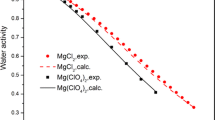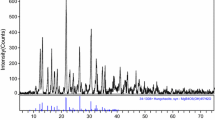Abstract
Pressure dependent UV-visible spectrophotometric measurements were used to determine\(\Delta \bar V^ * \) and\(\Delta \bar \kappa ^ * \) for the formation of alkali metal borate ion pairs. The association constant for each ion pair was measured at 25°C and at ionic strengths of 0.1 and 1.0m over a pressure range of 1 to 2000 atm. The pressure dependence of the apparent association constants, K A (P)/K A (1), have been fitted to
to determine\(\Delta \bar V^0 and \Delta \bar \kappa ^0 \). The\(\Delta \bar V^0 \) for the alkali metal borate ion pairs range from 5–9 cm3-mol−1. The association constants were also measured as a function of ionic strength at 1 atm. Extrapolation to I=0 yielded K A of 2.12, 0.66, 0.76 and 1.12 for [LiB(OH)4], [KB(OH)4], [RbB(OH)4] and [CsB(OH)4], respectively. The trend generally indicates less ion pairing and a smaller volume change for the ion pair formation as the size of the cation increases. The concept of localized hydrolysis is used to explain the trend observed in the equilibrium constant of the ion pair as the cation size is changed.
Similar content being viewed by others
References
H. Harder, inBoron Abundance in Natural Waters and in the Atmosphere K. H. Wedepohl, ed., (Springer, Berlin, 1970), p. 41–43.
R. H. Byrne and D. R. Kester,J. Marine Res. 32, 119 (1974).
L. M. Rowe, L. B. Tran, and G. Atkinson,J. Solution Chem. 18, 675 (1989).
H. Corti, R. Crovetto, and R. Fermandez-Prini,J. Solution Chem. 9, 617 (1980).
B. B. Owen and S. R. Brinkley,Chem. Rev. 29, 461 (1941).
K. S. Kitzer,J. Phys. Chem. 77, 268 (1973).
A. D. Pethybridge and D. J. Spiers,J. Chem. Soc. Faraday Trans. I 73, 768 (1977).
Critical Stability Constants, Vol. 4, R. M. Smith and A. E. Martell, eds., (Plenum Press, New York, 1976).
B. E. Conway,Ionic Hydration in Chemistry and Biophysics (Elsevier, New York, 1981), p. 582–604.
R. A. Robinson and H. S. Harned,Electrolyte Solutions (Butterworths, London, 1959), p. 455.
C. F. Baes and R. E. Mesmer,The Hydrolysis of Cations (Wiley, New York, 1976), p. 403–409.
R. D. Shannon and C. T. Prewitt,Acta Cryst. B25, 925 (1969).
G. K. Ward and F. J. Millero,Geochim. Cosmochim. Acta 37, 1595 (1975).
F. H. Fisher and A. P. Fox,J. Solution Chem. 7, 561 (1978).
W. L. Masterton, H. Welles, J. H. Knox, and F. J. Millero,J. Solution Chem 3, 91 (1974).
Author information
Authors and Affiliations
Rights and permissions
About this article
Cite this article
Rowe, L.M., Atkinson, G. The effect of pressure on the formation of alkali metal borate ion pairs at 25°C. J Solution Chem 19, 149–158 (1990). https://doi.org/10.1007/BF00646609
Received:
Revised:
Issue Date:
DOI: https://doi.org/10.1007/BF00646609




